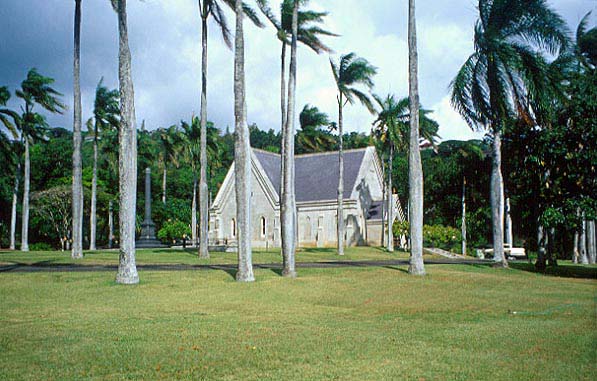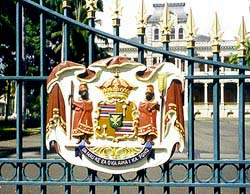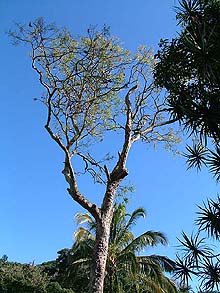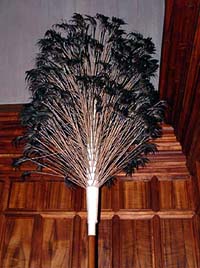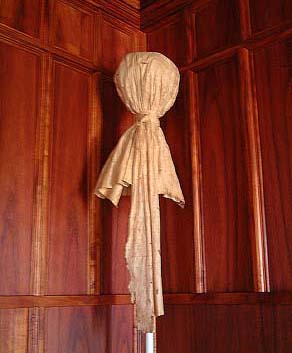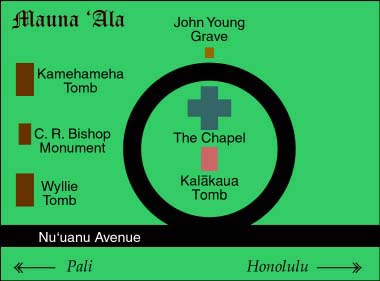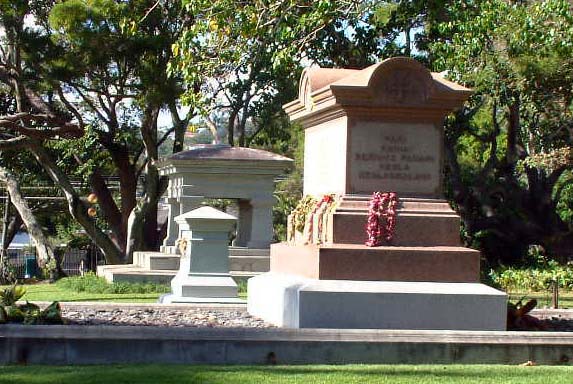 |
 |
 |
|||||||||||||||||||||
|
|
|
|
|
|
|
|
|
||||||||||||||||
|
|
|||||||||||||||||||||||
| |
|
|
The chapel at Mauna ‘Ala, the Royal
Mausoleum.
|
|
William John Kaihe‘ekai Mai‘oho was
appointed curator of Mauna ‘Ala in January of 1995. "My
mother was here for 28 years as kahu -- during her time it was
known more as kahu of Mauna ‘Ala," Bill tells us. "My
grandfather’s side of the family were chosen by Kamehameha the
Great to hide his iwi or his bones after his passing. Thus this
position here at Mauna ‘Ala was handed down through the generations.
Though my grandparents said not to 'take the bones of your ancestors
and display them'--in other words, don’t talk about your genealogy,
people already know--in today’s world, it’s a different thing.
Many people do not know of our family's traditional role." The role of Bill’s family as kahu of the iwi of the high chiefs comes with a story. Listen:
|
||
|
|
||
|
“Kamehameha the Great chose two high chiefs to hide his bones: Hoapili and Ho‘olulu, who were brothers. Hoapili was Kamehameha’s closest companion. Kamehameha gave him the name Hoapili which means 'attached to the bosom'--very, very close. “Previously there was another family that had the honor of caring for the iwi of Kamehameha’s family. But members of this family had told ship captains and sailors of sacred burial caves, that later were raided, and artifacts and things were taken. And when Kamehameha found this out, he removed that family and chose this family. Another reason was that they were blood-related to him."
|
|
|
|
“When the King passed away, the flesh was removed from the body by placing it on a shallow imu, and the flesh was melted off and wrapped in banana and ti, and taken far out to sea, where you cannot see land, and disposed of. It’s almost Christian-like in that, to the Hawaiians, the flesh was weak, and the iwi or the bones held the mana of the family, but the flesh of course, because of its deterioration, was at death considered corrupt. So it was taken and disposed of at sea. “The bones were then gathered, and mostly in ancient times they were wrapped in kapa, wrapped in feather ahu sometimes; some of their coffins in ancient times were canoes, favorite canoes of the high chief that were taken into burial caves and the iwi were placed inside these canoes. A lot of the history that I’ve read was the haole anthropologists asking, 'How did they get the canoe in the cave?' The cave is right, straight up a cliff, you know? A real puzzle!"
|
|
“But the most sacred high chiefs, or the ones that have won glory in their life--and glory was to perpetuate the race, to increase the race, food, farming, how good the high chiefs were to the maka‘ainana, or the common people, and these very sacred high chiefs were placed in a ka‘ai, which is sennit cordage that was woven around the bones of these ancestral chiefs. You can make up the upper torso of the human form, and they had mother-of-pearl inlaid for their eyes, and they had teeth embedded where their mouths were, and they were then hidden away." Two of these ka‘ai were mentioned in the discussion of Pohukaina. Learn more about these ka‘ai from Jim Bartels and Bill Maioho.
|
|
|
|
|
|
"When it came the time to bury Kamehameha, Hoapili and Keopulani were on a canoe out at sea. Ho‘olulu gathered the iwi of Kamehameha inside the ka‘ai, placed it on his back, and he was going to meet Hoapili and Keopulani. This of course was done at night, when the gods were watching, and the kapu weren’t as stringent on the high chiefs as they were during the day. And it was a Po-kane night, without any moon. Though even though there were kapus, people would still sneak out and take a look. "Ho‘olulu meets up with Hoapili and Keopulani, and in our mo‘olelo, our family history, they go out and place Kamehameha the Great in an undersea cave where not even the eyes of man can look on his burial site. When they got through discharging their duty to the King, they came back. Ho‘olulu had a son born to him within a week, or very soon after. And he named that son, Kai-he‘e-kai, which the literal translation is 'ocean octopus ocean,' but in the kaona or hidden meaning of the name, it means 'the receding tide,' like the octopus recedes into the puka and hides. It was low tide when they went out to this burial cave, and placed Kamehameha in it. "And so we descend from two high chiefs who hid the bones of Kamehameha the Great. That name, Kaihe‘ekai, has come down from Ho‘olulu. I now carry it. I am the fourth Kaihe‘ekai from Ho‘olulu. My grandfather was the second one; my grandpa’s grandpa was Kaihe‘ekai the first one; and my son is the fifth Kaihe‘ekai. And hopefully one day he’ll be here in this position."
|
||
|
|
||
|
|
The passing of Ka Haku o Hawai‘i--the young prince of Hawai‘i at the age of four--begins the story of Mauna ‘Ala itself: "King Kamehameha IV and Queen Emma chose this site, called Mauna ‘Ala, to erect this larger mausoleum building. The mausoleum building on the grounds of ‘Iolani Palace was full, and they built a temporary shelter alongside of that building for the Prince. "This site was chosen for its sacredness. There are petroglyphs alongside of Nu‘uanu Stream, just below Mauna ‘Ala, that lend to the mystique or the mana of Mauna ‘Ala.This was one of the first successful battle sites on O‘ahu for Kamehameha, in chasing Kalanikupule and his warriors further up the valley. Before that, this was the battle encampment of Kalanikupule, the high chief of O‘ahu. "Mauna ‘Ala means 'fragrant mountain.' And this lends itself to the Hawaiian cultural tradition that fragrances would bring back memories of your loved ones, of special events that happened in your life, special places. And that would all be included in the mana of the iwi of the Kamehamehas."
|
| "They chose an architect, a German man by the name of Theodore Heuck, to design the building, with the input of the King and Queen. Kamehameha IV and Kamehameha V had traveled to Europe and seen the burial places of kings in Europe. The King wanted one built along the European lines: the high beam ceilings, and the arched doorways and arched windows." Kamehameha IV and Queen Emma also had close links with the Anglican Church. They made a request personally to Queen Victoria, to send a bishop from the Anglican Church to Hawai'i. They also requested Queen Victoria to be the godmother of Ka Haku o Hawai'i. "Queen Victoria consented to both requests, and sent as a gift a silver christening cup, about three feet high, and very elaborate." The Prince passed away after his baptismal, on August 27, 1862.
|
|
|
"King Kamehameha IV takes ill soon afterwards, and passes away November 30, 1863, 15 months after his son. His brother Lot Kamehameha comes to the throne of Hawai‘i as King Kamehameha V. Immediately he starts construction of the mausoleum building. And they build the West Wing of the building, or the ‘Ewa Wing, which is completed at the end of January 1864. "On February 3, 1864, they have a large national funeral for the King -- takes place from ‘Iolani Palace and Kawaiaha‘o Church. The King is brought here in procession, and his casket is placed on a casket stand in that wing of the building. Later in the evening, ceremonially, they bring Ka Haku o Hawai‘i up and lay him to rest alongside his father. Queen Emma is so overcome with grief at the loss of her family that she camps here, on the grounds of Mauna Ala, and sleeps in that wing of the building with her husband and son, just grieving.
|
"They then wait a year, a period of mourning, before completing the other three wings of the building. The building is completed in October of 1865. On the night of October 30, 1865, King Kamehameha V and his father, Kekuanaoa, along with other retainers and members of the royal family, lead a procession from Pohukaina, bringing 18 members of the Kamehameha family. "And this is done at night, when the gods are present. It is done with all the ceremonies attached to the Kamehameha dynasty using the feather kahili, kukui-nut torches, and . "King Kalakaua then brings his family members here to Mauna ‘Ala in November of 1875."
|
|
|
|
|
|
|
|
"It was Queen Lili‘uokalani's wish and vision to convert the mausoleum building into a chapel, to be used specifically to celebrate the birthdays of Hawai‘i’s kings and queens and their legacy of aloha, left to the Hawaiian people through the various trusts created by these high chiefs and high chiefesses, to care for their people. "On March 26, 1922, on the birthday of Prince Kuhio, the chapel is dedicated in his memory, and has been used from that time until today to celebrate the birthdays of Hawaii’s kings and queens. "A resolution drafted by Robert Wilcox -- Hawaii’s first delegate to congress -- and Queen Lili‘uokalani, and passed by the Congress of the United States of America, removed these 3.5 acres of sacred land from the public domain. Mauna Ala is not a part of the Land Laws of the United States, or of the State of Hawaii. It is the only known place in the United States where the flag of the Kingdom of Hawai‘i is permitted to fly unaccompanied by the American Flag. So some people say, 'Okay, if we break the law, we can come over here, and they no can come get us.' I say, 'Well you can try that, but, uh, they going come get you'."
|
||
|
|
||
|
A celebration at the Kamehameha tomb.
|
Today, Mauna ‘Ala is managed by the State Parks division of the Hawai‘i Department of Land and Natural Resources (DLNR). This piece of old Hawai‘i sits quietly on a less-travelled portion of Nu‘uanu Avenue, but remains a focal point for Hawaiian organizations and celebrations concerned with the Kingdom and the Monarchy. Go now to learn of the overthrow of the Kingdom.
|
||
|
|
||
| |
| |
|
|
 |
| Nu‘uanu Home | Map Library | Site Map | Hawaiian Islands Home | Pacific Worlds Home |
|
|
|||
| Copyright 2003 Pacific Worlds & Associates • Usage Policy • Webmaster |
|||
